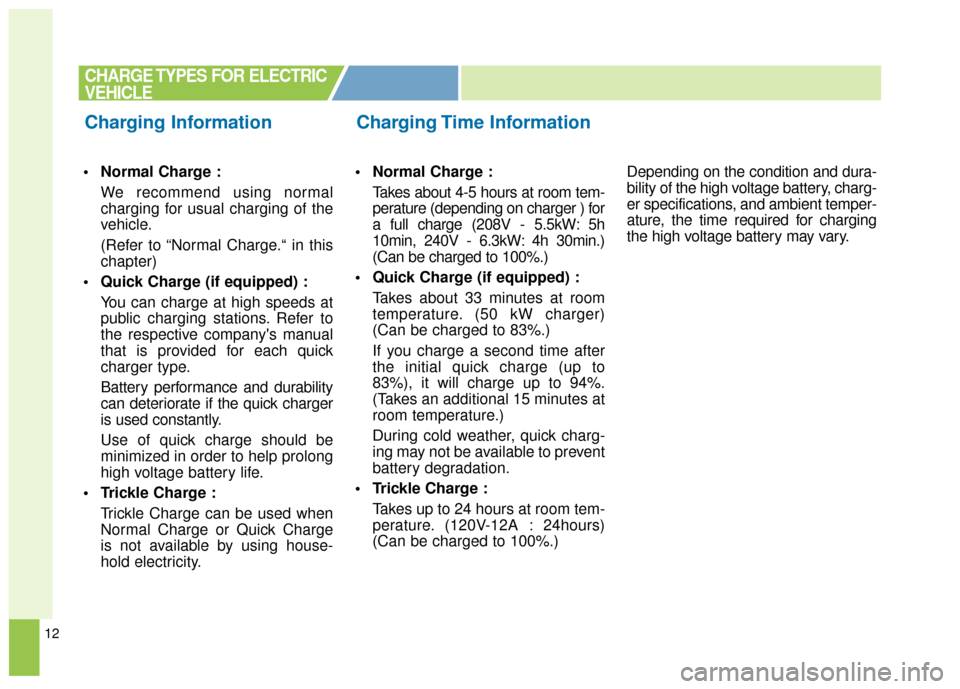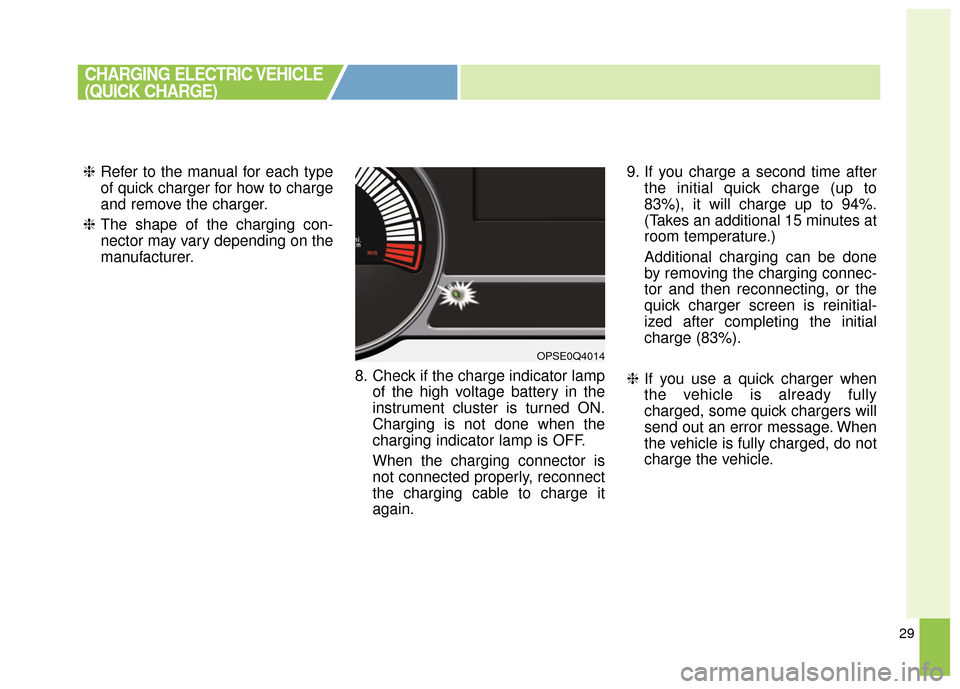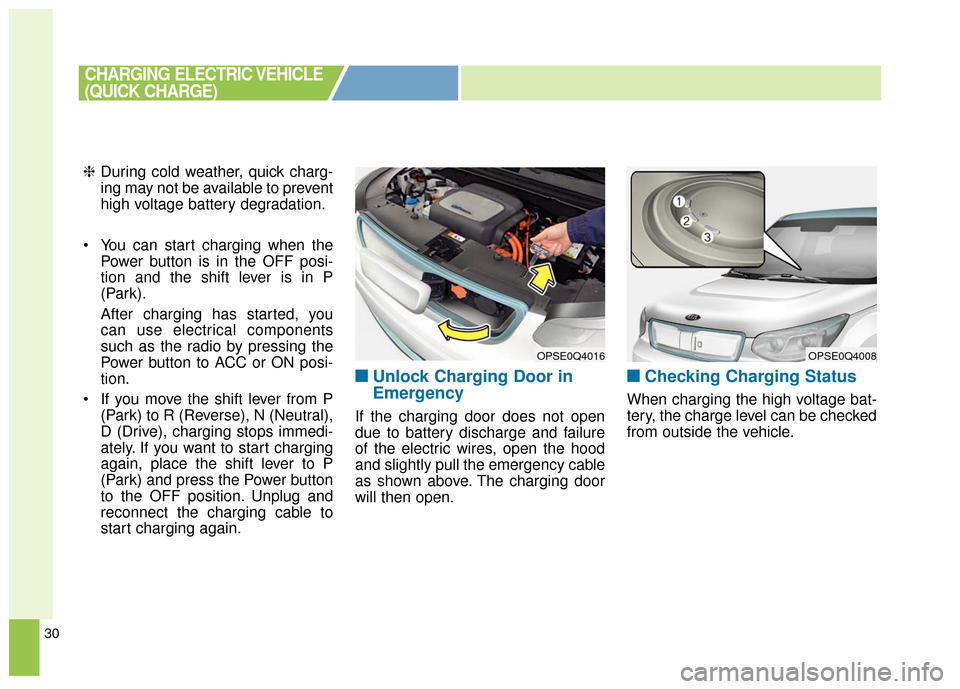Page 477 of 524

12
Normal Charge :We recommend using normal
charging for usual charging of the
vehicle.
(Refer to “Normal Charge.“ in this
chapter)
Quick Charge (if equipped) : You can charge at high speeds at
public charging stations. Refer to
the respective company's manual
that is provided for each quick
charger type.
Battery performance and durability
can deteriorate if the quick charger
is used constantly.
Use of quick charge should be
minimized in order to help prolong
high voltage battery life.
Trickle Charge : Trickle Charge can be used when
Normal Charge or Quick Charge
is not available by using house-
hold electricity. Normal Charge :
Takes about 4-5 hours at room tem-
perature (depending on charger ) for
a full charge (208V - 5.5kW: 5h
10min, 240V - 6.3kW: 4h 30min.)
(Can be charged to 100%.)
Quick Charge (if equipped) : Takes about 33 minutes at room
temperature. (50 kW charger)
(Can be charged to 83%.)
If you charge a second time after
the initial quick charge (up to
83%), it will charge up to 94%.
(Takes an additional 15 minutes at
room temperature.)
During cold weather, quick charg-
ing may not be available to prevent
battery degradation.
Trickle Charge : Takes up to 24 hours at room tem-
perature. (120V-12A : 24hours)
(Can be charged to 100%.) Depending on the condition and dura-
bility of the high voltage battery, charg-
er specifications, and ambient temper-
ature, the time required for charging
the high voltage battery may vary.
CHARGE TYPES FOR ELECTRIC
VEHICLE
Charging Information Charging Time Information
Page 483 of 524
18
❈Shape of charger and how to use
the charger may be different for
each manufacturer.
PRECAUTIONS FOR CHARGING
ELECTRIC VEHICLE
Charging Precautions
OPSE0Q4057N
■ Normal Charger
OPSE0Q4004
■ Quick Charger
WARNING - Fires caused
by dust or water
Do not connect the charging
cable connector plug to the
vehicle if there is water or dust
on the charging inlet.
Connecting while there is water
or dust on the charging cable
connector and plug may cause
a fire or electric shock.WARNING - Interference
with electronic medical
devices
When using medical electric
devices such as an implantable
cardiac pacemaker, make sure
to ask the medical team and
manufacturer whether charging
your electric vehicle will impact
the operation of the medical
devices. In some instances,
electromagnetic waves that are
generated from the charger can
seriously impact medical elec-
tric devices such as an
implantable cardiac pacemaker.
Page 487 of 524
22
5. Open the charging door and pressthe normal charging inlet cover
release tab (1) to open the normal
charging inlet cover.
6. Before connecting the charging connector, make sure the door
lock is released.
When the door is locked, the
charging connector lock system
will be triggered. And the charging
connector will not be connected. 7. Remove any dust on the charging
connector and charging inlet.
8. Hold the charging connector han- dle and connect it to the vehicle
normal charging inlet. Push the
connector until you hear a "click-
ing" sound.
CHARGING ELECTRIC VEHICLE
(NORMAL CHARGE)
OPSE0Q4013OPSE0Q4012
CAUTION- Charging
Connector Door
To avoid damage to your vehi- cle, do not attempt to connectthe charging connector to yourvehicle without first opening thedoor to the charging connector.
Page 489 of 524
24
Depending on the condition and
durability of the high voltage battery,
charger specifications, and ambient
temperature, the time required for
charging the battery may vary.11.You may prevent possible charg-
ing cable theft by taking the fol-
lowing steps. Lock the door after
the charging cable is connected,
by pressing the lock button on the
smart key or on the central door
lock switch.
When the door is locked, the
charging connector will become
locked and this will prevent possi-
ble theft.
So, after charging is complete,
you must release the door lock in
order to disconnect the charging
connector.
■ ■Unlock Charging Door in
Emergency
If the charging door does not open
due to battery discharge and failure
of the electric wires, open the hood
and slightly pull the emergency cable
as shown above. The charging door
will then open.
CHARGING ELECTRIC VEHICLE
(NORMAL CHARGE)
OPSE0Q4016
Page 491 of 524
26
■ ■How to Disconnect Normal
Charger
1. Before disconnecting the charging
connector, make sure the door
lock is released. When the door is
locked, the charging connector
lock system will be triggered. And
the charging connector will not be
disconnected. 2. Hold the charging connector han-
dle and pull it while pressing the
release button (1).
3. Make sure to completely close thenormal charging inlet cover.
4. Make sure to completely close the charging door.
CHARGING ELECTRIC VEHICLE
(NORMAL CHARGE)
OPSE0Q4034
OPSE0Q4015CAUTION- Disconnecting
charging plug
When disconnecting the charg-ing connector, do not try to dis-connect it by force while notpressing the release button. Thismay damage the charging con-nector and vehicle charging inlet.
CAUTION
In order to disconnect thecharging connector, release thedoor lock to unlatch the charg-ing connector lock system. Ifnot, the charging connector andthe vehicle's charging inlet maybe damaged.
Page 492 of 524
27
You can charge at high speeds at pub-
lic charging stations. Refer to the
respective company's manual that is
provided for each quick charger type.
Battery performance and durability can
deteriorate if the quick charge is used
constantly in hot weather conditions
(heat wave, etc.)
Use of quick charge in hot weather
condition should be minimized in order
to help prolong high voltage battery life.
❈Shape of charger and how to use
the charger may be different for
each manufacturer. ❈
If you use a quick charger when
the vehicle is already fully
charged, some quick chargers will
send out an error message. When
the vehicle is fully charged, do not
charge the vehicle.
■ ■
How to Connect Quick
Charger
1. While the brake pedal is pressed,
engage the parking brake.
2. Turn OFF all switches, place the shift lever in P (Park), and turn
OFF the vehicle.
Quick Charge (if equipped)
CHARGING ELECTRIC VEHICLE
(QUICK CHARGE)
OPSE0Q4004
OPSE0Q4011
■ Quick Charger
Page 494 of 524

29
❈Refer to the manual for each type
of quick charger for how to charge
and remove the charger.
❈ The shape of the charging con-
nector may vary depending on the
manufacturer.
8. Check if the charge indicator lampof the high voltage battery in the
instrument cluster is turned ON.
Charging is not done when the
charging indicator lamp is OFF.
When the charging connector is
not connected properly, reconnect
the charging cable to charge it
again. 9. If you charge a second time after
the initial quick charge (up to
83%), it will charge up to 94%.
(Takes an additional 15 minutes at
room temperature.)
Additional charging can be done
by removing the charging connec-
tor and then reconnecting, or the
quick charger screen is reinitial-
ized after completing the initial
charge (83%).
❈ If you use a quick charger when
the vehicle is already fully
charged, some quick chargers will
send out an error message. When
the vehicle is fully charged, do not
charge the vehicle.
CHARGING ELECTRIC VEHICLE
(QUICK CHARGE)
OPSE0Q4014
Page 495 of 524

30
❈During cold weather, quick charg-
ing may not be available to prevent
high voltage battery degradation.
You can start charging when the Power button is in the OFF posi-
tion and the shift lever is in P
(Park).
After charging has started, you
can use electrical components
such as the radio by pressing the
Power button to ACC or ON posi-
tion.
If you move the shift lever from P (Park) to R (Reverse), N (Neutral),
D (Drive), charging stops immedi-
ately. If you want to start charging
again, place the shift lever to P
(Park) and press the Power button
to the OFF position. Unplug and
reconnect the charging cable to
start charging again.
■ ■Unlock Charging Door in
Emergency
If the charging door does not open
due to battery discharge and failure
of the electric wires, open the hood
and slightly pull the emergency cable
as shown above. The charging door
will then open.
■ ■Checking Charging Status
When charging the high voltage bat-
tery, the charge level can be checked
from outside the vehicle.
OPSE0Q4016
CHARGING ELECTRIC VEHICLE
(QUICK CHARGE)
OPSE0Q4008